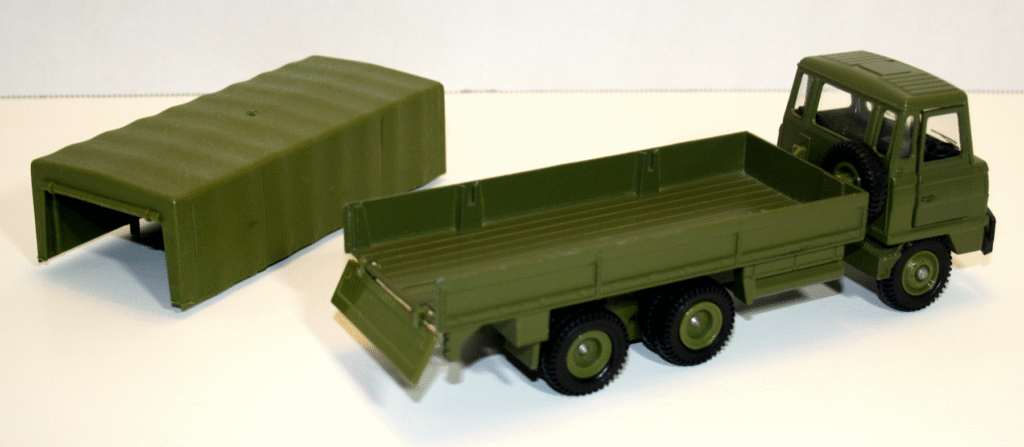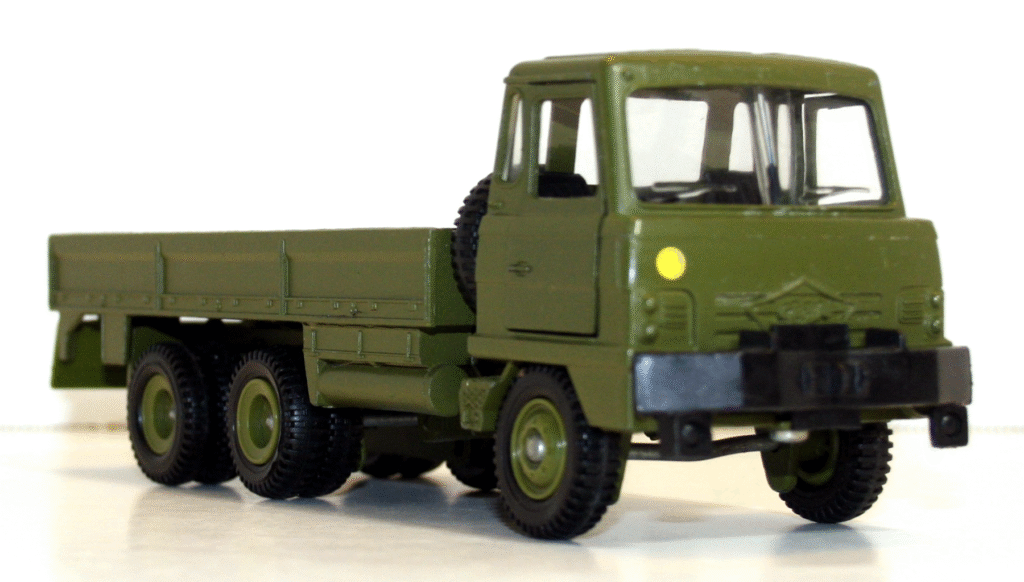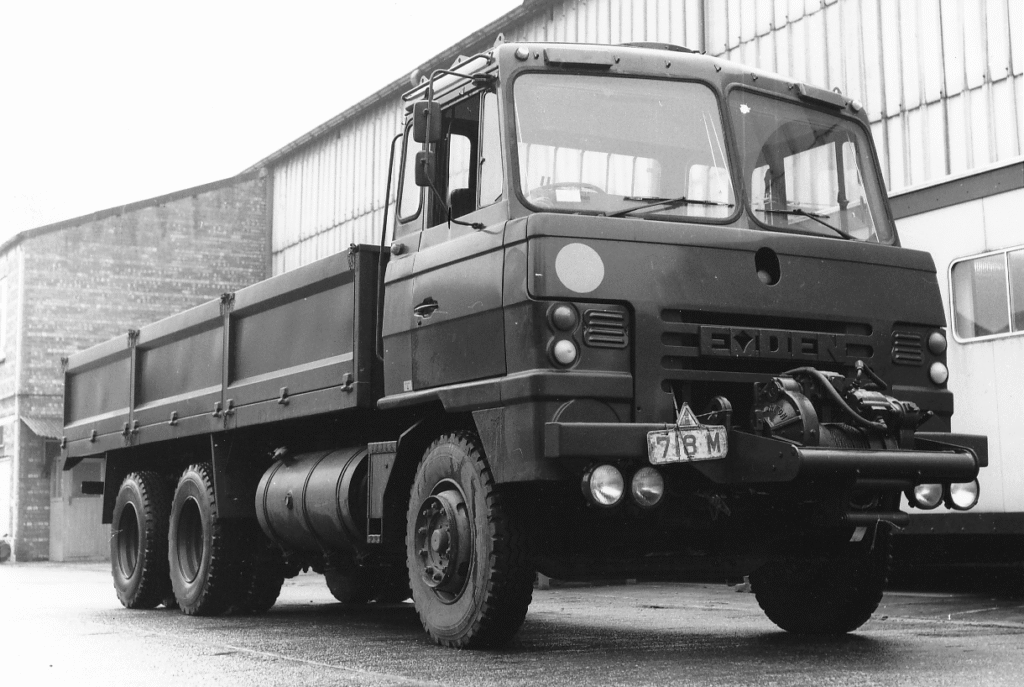
When Dinky collectors, especially those who collect commercial vehicles, hear the words “Dinky Foden”, they likely immediately think of the four-axle, eight-wheel Foden trucks that debuted in 1947. These golden-age models were the first Dinky Supertoys; they sold very well right up to 1964. They are still incredibly popular after all these years, and some variants are extremely valuable. The real-life Foden trucks on which they were based were instrumental in the rebuilding of post-war England and were exported all over the world.
By contrast, when a Dinky collector like me — who was born in 1970 and was lucky to enjoy the last decade of Dinky toys’ production — hears the word “Foden”, I only think of the big 1/42 scale 432 S90 dump truck, 668 army truck, and 950 tanker models that were first released in 1976. These robust models all shared the same cab that featured crisp casting details of the Foden kite grill emblem, marker and headlights, opening doors that showed off a detailed interior, and realistic plastic wheels with rubber tires. These were all typical features of 1970s Dinky toy vehicles and offered great play value to kids. The original, golden era Dinky Foden models never cross my mind when I think of a Dinky Foden, nor do I have any in my collection.
432 Foden Dump Truck
The last Dinky Fodens were modelled on the new Foden S90 Universal range of trucks. The real Foden S90 was a heavy cabover or forward control truck that featured a steel tilt cab that was manufactured by Motor Panels of Coventry for Foden. This cab was uniquely crafted to complement Foden’s then all new Universal range that was designed for the European and overseas export market. It shared the same distinctive, large 11-inch Lucas headlights as the Foden S80 and 83 models. The lights were road legal in the UK but not in many export markets, so when exported they were fitted with a larger steel bumper fitted with four smaller headlights. It was first shown in February 1974 at the Amsterdam Commercial Vehicle Show.
The show star of the three Dinky Foden models was the 432 Foden dump truck that was released in 1976. It was a 6x4 chassis that featured a functioning tipper and tailgate, red cab interior, black twin exhaust stacks and a semi-articulated rear axle that gave some realistic wheel travel. It was based on the actual 1974 Amsterdam show truck and has a fascinating story that most Dinky fans are unaware of.
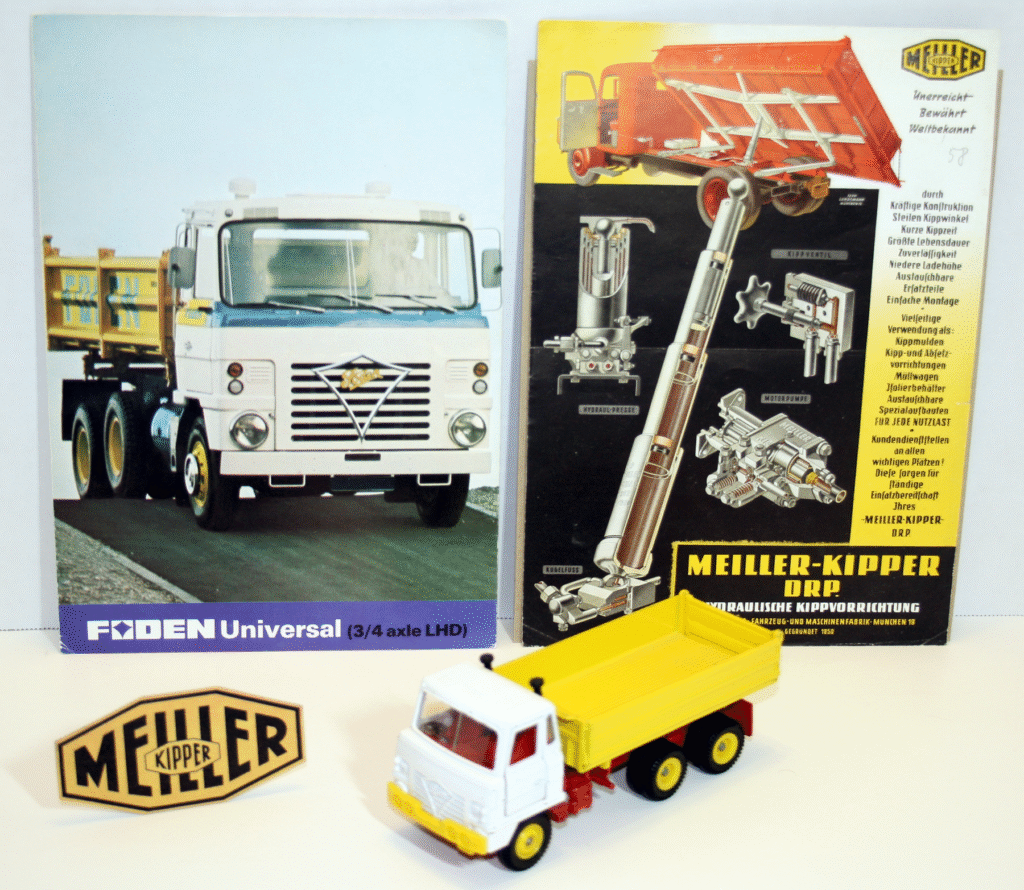
The Dinky Foden 432 dump truck is shown here with the Foden Universal brochure which pictures the S90 Universal dump truck that Dinky modelled the 432 from. The actual truck was first shown at the 1974 Amsterdam Commercial vehicle show. It was designated as RC33/26 Universal, powered by a Cummins NTC335 engine and was fitted with a German Meiller three way tipper which is also shown here in a vintage Meiller brochure.
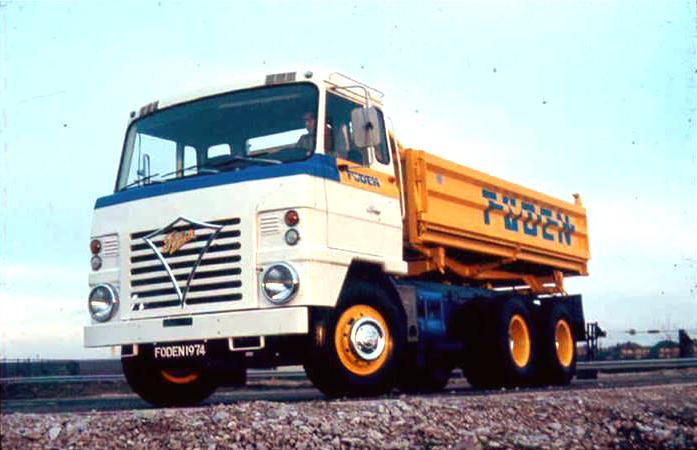
Two more views of the 1974 show truck. This first photo clearly shows the underside of the Meiller three-way tipper and side tipper hinges which Dinky captured in the 432 casting.
Image: Brian Lomas and Chris Wallwork of the Foden Society.

This next photo is the truck on display in Amsterdam with the dump body up. Foden show trucks at this time were painted in eye-catching yellow, blue and white.
Image: Brian Lomas and Chris Wallwork of the Foden Society.

The Dinky retailer poster and 1977 catalog picture for the 432 showed an early mockup illustration. Note the super single cast wheels on the rear and absence of the export bumper.
The show truck was designed for the export market, and it was a right hand drive model. Most interesting was the tipper body. It was a German-made Meiller three-way tipper, which was very common in the German and Dutch markets. Due to weight laws, these tippers are not seen in the UK. The 432 tipped to the rear only for obvious cost reasons, but the Dinky model makers did manage to capture the unique casting detail of the Meiller body. Three-way tippers have hinge points on both sides of the tipper; Dinky brilliantly reproduced these. There is also a large gap between the top of the rear wheels and the bottom of the tipper body; this enables the side of the tipper to have clearance when the load is discharged on either side. Dinky replicated this as well. I have owned my 432 since childhood, and as a kid I never knew what the extra casting detail was for. I found the gap between the tipper body and the rear wheels strange when compared to my other dump truck models. It would be many years before I realized the basis for this Dinky tipper.

Despite the economizing that was in full effect at Dinky then, this corrugated card step demonstrates the impressive for a toy wheel travel on the forward axle of the rear tandem bogie. The 668 army truck chassis shared the same feature. None of my other diecast dump truck toys as a child had this much wheel travel.
The show truck didn’t have the export bumper, but the model did. One must assume that when the Dinky model makers went to photograph and study the actual truck for production, they must have been told by Foden it was an export model; thus the bumper being fitted to the 432.

The only variants on the dump trucks were the wheel and cab colors and the colors of the dump body hydraulic piston sleeve. The sleeves seen here are grey and black, with black being the most common. The yellow wheels with white cab is very common while the model with white wheels is a harder to find version. The red cab is very rare and shared with the tanker tractor. Note the black interior and silver headlights visible behind the export bumper.
The 668 Army Truck
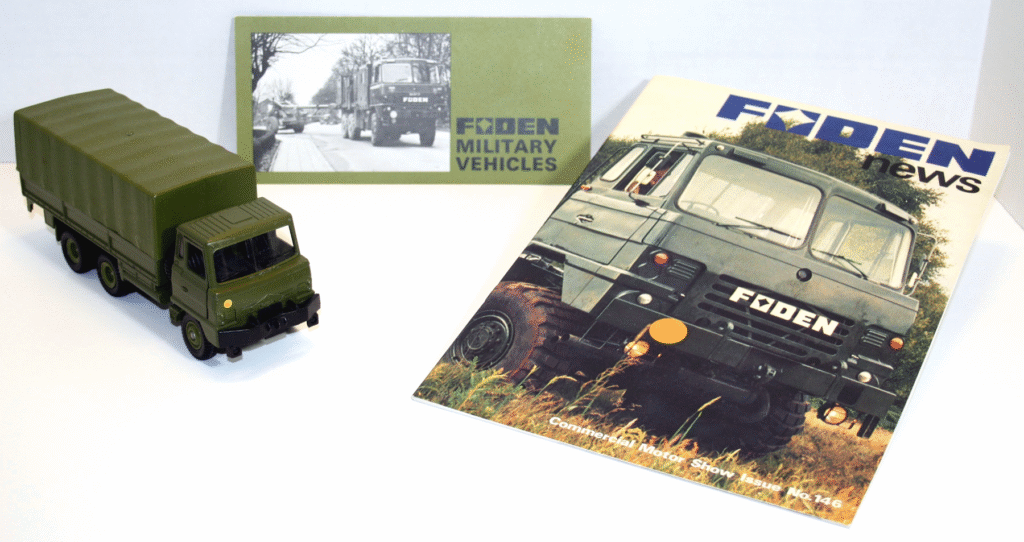
The 668 Army truck was also released in 1976 is pictured here with a Foden military vehicle brochure and issue 146 of the1974 Foden news showing a medium mobility military S90 on the cover.
The next Foden S90 model, also released in 1976, was the 668 army truck. Meccano utilized the same 6x4 chassis as the 432 tipper for the 668. It was fitted with a crisply diecast, low-side cargo body with a removeable plastic tilt, black cab interior, rear tow hook, OD green wheels, and an operating tailgate. The cab was fitted with a large military winch type front bumper with headlights underneath. A spare tire and extra fuel can were fitted in place of the twin exhaust stacks on the tipper. The exhaust on this military model was mounted below in the chassis as on the real truck. A decal sheet with fictitious military markings was included as well. Like the dump truck, the Dinky model makers did a great job replicating this model from the real truck, the S90 low mobility. With a 6x4 drivetrain, these trucks were not designed for serious cross country off road travel, thus the low mobility designation. Over 1,200 different versions were produced.
The 668 was based on the real Foden 6x4 army truck which can be seen in the last below photo. Note the good casting detail on the three section drop down sides of the cargo bed on the Dinky compared to the actual truck. The real truck was designated 46K023R2209 and powered by a Rolls-Royce 220Mk3 engine. The drop side cargo beds were supplied by Marshalls of Cambridge. Note the two-piece windscreen which was only found on military S90 cabs. This example dates from 1978. Photo courtesy of Wobbe Reitsma.

The Dinky dealer poster for the 668.
Interestingly, in 1975, Dinky made a prototype model of the Foden Medium Mobility 6x6 Gun Tractor which uses the chassis of the 668. Plans were made for the then new MH70 howitzer it was designed to tow in real life. With such detailed models, obviously the cost was going to be extreme and so they never entered production. But they would have been fabulous models with lots of working features and large super single wheels. As a child, I would hook up my Dinky 88mm gun to the 668 and tow it.

This French market Foden ad featured the Foden gun tractor which also utilized the S90 cab on a 6x6 medium mobility chassis.
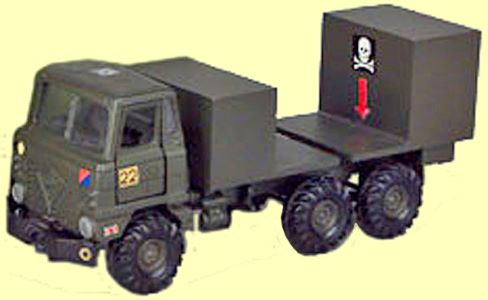
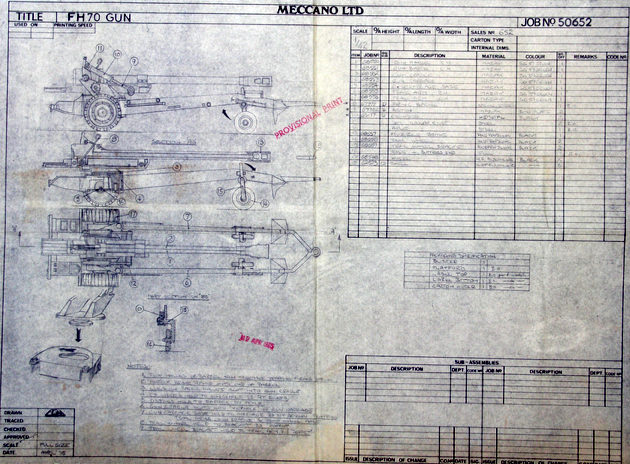
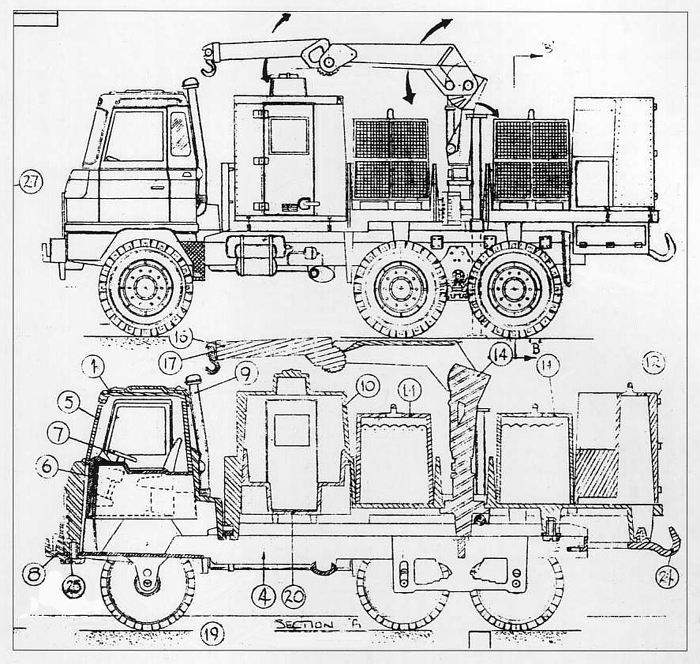
In 1975 Dinky proposed a model of this truck and the FH 70 howitzer it towed. A basic prototype of the gun tractor was made but due to the high production costs involved both models were never released. The functioning Atlas crane, outriggers and removeable ammunition pallets would have made it a fantastic toy with lots of play value. The prototype model shown here was sold at auction in the 1990’s. Plans and prototype photos courtesy of Jacques Dujardin’s Dinky Toys Encyclopedia.
For 1980, Dinky planned a civilian version of the 668 with a yellow plastic tilt liveried for Chris Hudson, a trucking company that was located near the Binns Road factory. A crudely finished prototype exists with sloppily hand painted yellow chassis and wheels. It was finished in metallic green, the same awful shade as the Dinky Eagle Transporter and UFO Interceptor models.
The 950 Fuel Tanker
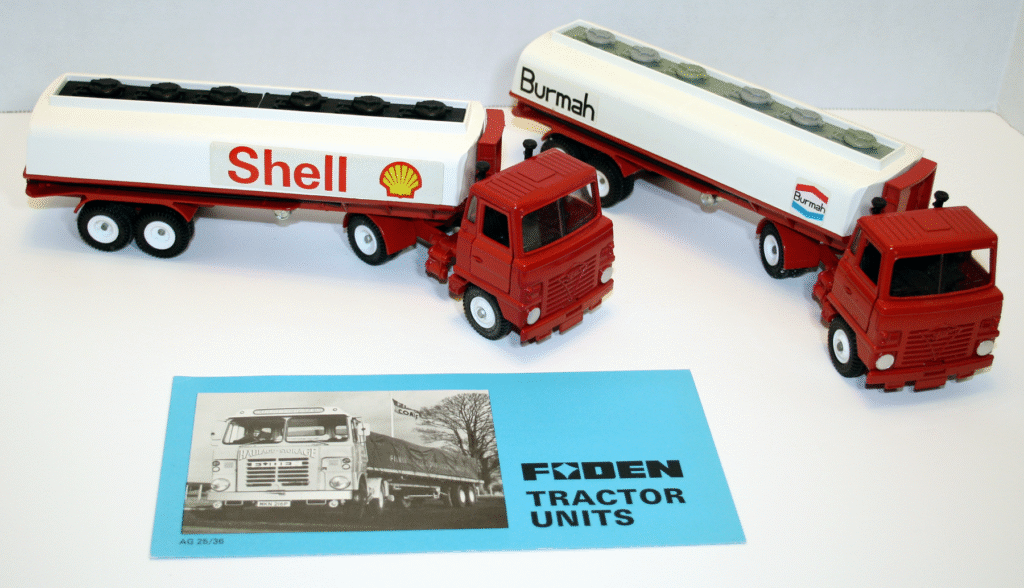
The tanker models were the last to be released in 1978 and Dinky did a superb job modelling the S90 tractor. The exposed headlights and cast in chassis bumper give the model a very different look when compared to the dump and army truck models. Both versions are shown here along with a Foden tractor brochure.
In 1978, the last Dinky Foden S90 to be introduced was the 950 fuel tanker; it was offered in two liveries, Burmah and Shell. Meccano modelled the tanker tractor on the prototype that was first shown by Foden at London’s Earls Court Commercial Vehicle Show in 1974. The most common version, the Burmah, was released first. The Shell version would follow later; it is the scarcest. The Dinky 6x4 chassis was shortened to an attractive S90 Universal 4x2 tractor. The accurately cast large headlights were exposed, and a conventional bumper was fitted as part of the chassis casting. The handsome tractor shared the twin exhaust stacks with the 432-dump truck, had a black cab interior, and pulled the familiar tanker trailer from the recently withdrawn 945 AEC Esso tanker.
The last runs of the older 945 Esso tanker had plastic tank bodies. These were carried over to the Foden’s trailer, as were the Esso tankers’ functioning trailer landing gear, opening filler caps, and a pair of removable hoses. A very simple fifth wheel for trailer hook up was cast into the tractor, and there was a great deal of play value with this model. The wheels and tires on these 1/42 scale Fodens were bigger than the old wheels on the 945, so the trailer bogie area was enlarged on the chassis to accommodate them. This trailer was a fine example of Dinky recycling the old for a new model.
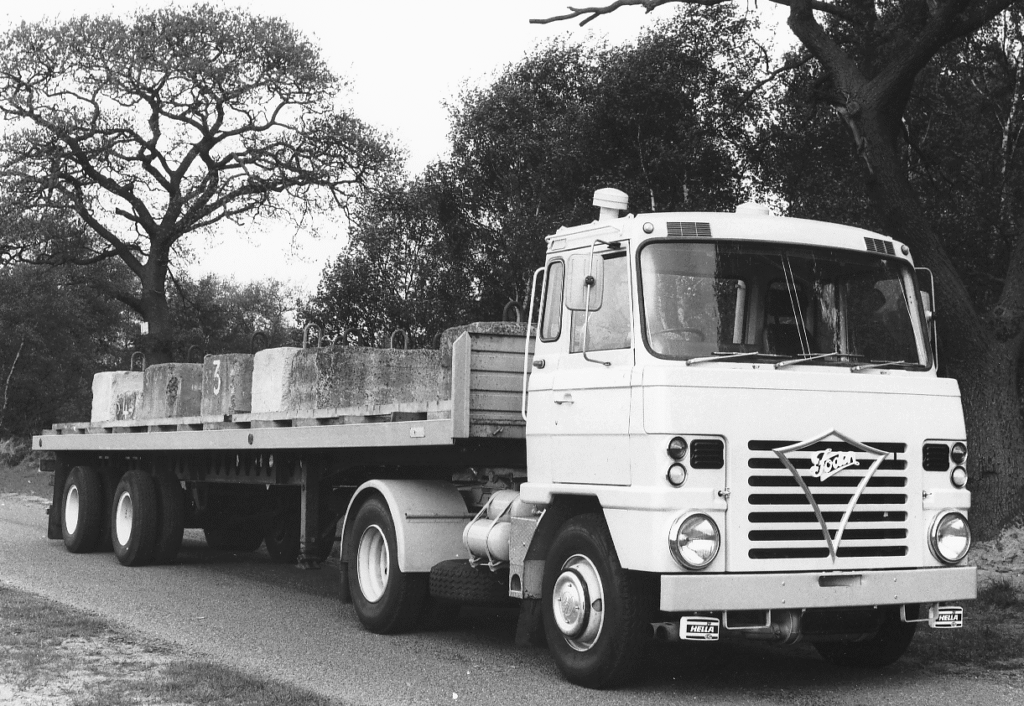
The real S90 4x2 tractor prototype was a 38-ton AR22/38 Universal model, powered by a Rolls Royce 220 engine. It’s seen here on test pulling a heavy load of concrete blocks. Note the Hella driving lights.
Image: Wobbe Reitsma

The 1977 Dinky catalog showed a unique pre production Burmah tanker tractor that featured the export bumper and a black chassis.

The 1978 Meccano trade catalog had an attractive motorway scene cover with a Burmah tanker along with Meccano building kits that mimicked tall buildings. Note all the black chassis tractor just like the pre production model.
According to the late David Busfield, shortly before the 950 tankers entered production in 1978, some plastic copies were made as samples and sent to Parodi, the long time Genoa, Italy based Italian distributor of Meccano products. Mounted on attractive wooden plinths, there was a Burmah tanker which he owned and an attractive army version that almost made it to production. Both models were sold in 2017 by C&T Auctioneers for the Parodi family.

Planned for 1980, this impressive prototype military version of the tanker was sent as a sample to Parodi, the long time Italian Meccano distributor. It was sold by C&T auctioneers in 2017.
Image: The late David Busfield.
As collectibles, all three models are still quite affordable. I have seen the dump and army trucks in mint/boxed condition sell for as little as US $30. Both are for sale regularly on eBay in the USA. The tankers rarely show up in the USA but are commonly seen for sale in the UK and Europe. The Burmah livery is usually around US $50 in mint boxed condition and the Shell version is higher priced. All three models were only offered in the last issue, hanging type window boxes and there were no casting variants.
As nice as these trucks are, due to their large size scale and numerous operating features, most Dinky collectors shun them, as they many 1970s Dinky toys. This is lamentable, as they represent three of the most realistic Dinky commercial vehicles ever made, even in a time of serious cost cutting.
Dinky had many firsts in its long history of toymaking, and it was the first and only toy maker to ever make a mass produced toy model of the Foden S90. As such, I asked Chris Wallwork of the Foden Society if any of the Dinky models were used for promotional purposes by Foden. He shared that after checking with some of the former Foden employees, no one could recall.
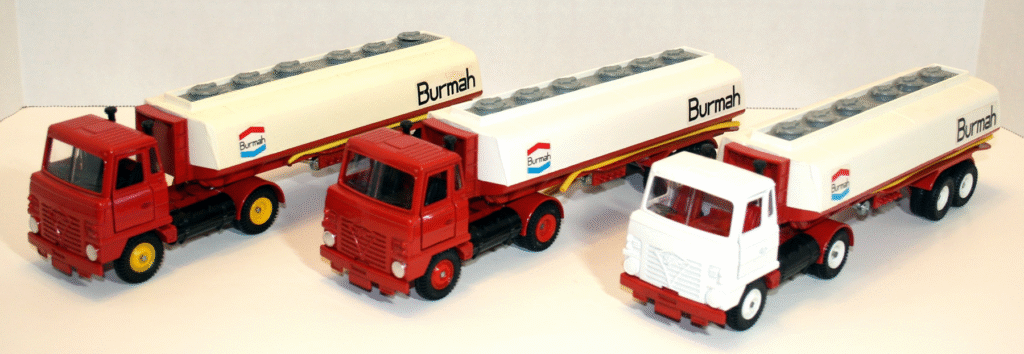
The only variants of the tankers were wheel, cab, filler cap and hose colors. The filler caps were silver or black and hoses can be yellow, black or grey. Besides the usual white wheels they were also yellow and red which are harder to find. A very attractive variant is the rare white dump truck cab version.

The last time the Foden tanker and dump truck were ever seen together was in the 1980 Airfix Dinky catalog, the very last Dinky catalog. Most interesting was the painted details on the grill and ancillary lighting on the Shell tanker tractor.

The trade pack for the 950 tanker came in a group of four shrink wrapped models which makes for a large and quite heavy package. Few collectors post or talk about this final era of Dinky shrink wrapped trade packs.
This article was first published in the January 2025 issue of the DTCA Journal. The three Dinky S90 models that have been discussed here (the 432 and the 668) were never written about before in the Journal.
In addition to the gun tractor and civilian prototype versions of the 668, there were other prototype versions made and planned of the 950 tankers which are not discussed here. These were previously covered in detail by Michael Forbes in the January 2018 issue of the Journal. If you like these Foden models as much as I do, I suggest reading Michael’s Journal tanker article as well as his article in the January 2013 issue of Model Collector Magazine, which covers even more prototypes. Regarding real Fodens, Wobbe Reitsma’s books, Foden Export Vehicles and Foden Special Vehicles, are the definitive works on Foden. I highly recommended them, and they are the go-to Foden books in my commercial vehicle library.
This article was a special one for me. As a lifelong commercial vehicle enthusiast, the later Foden trucks have always been one of my favorite English trucks, and I have owned my 432 Tipper and 668 Army Truck (shown in this article) since I was 9 years old. To be writing about them decades later and have them pictured with the rest of my Dinky Foden collection in this article is a real treat.
Foden went out of business in 1980, a year after Dinky. Sadly, while there was no savior for Dinky, Foden got a new lease on life when it was purchased by the American Paccar company (Pacific Car and Foundry), the owners of Kenworth, Peterbilt and DAF. Foden would soldier on until 2006 when due to a shrinking market the brand was unfortunately discontinued. Its legacy continues, supported by a loyal base of fans and the Foden Society much like the world wide group of Dinky collectors.
Acknowledgement
Writing an article like this is never a one person endeavor and special thanks go to Wobbe Reitsma, Chris Wallwork and Brian Lomas of the Foden Society, the late David Busfield, Jacques Dujardin, and Jonathan Angel.
